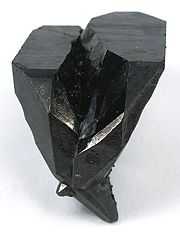Ferberite
| Ferberite | |
|---|---|
 Fluorapatite on ferberite from Minas da Panasqueira, Beira Baixa, Portugal | |
| General | |
| Category | Tungstate minerals |
| Formula (repeating unit) | FeWO4 |
| Strunz classification | 04.DB.30 |
| Crystal symmetry |
Monoclinic prismatic H-M symbol: (2/m) Space group: P 2/c |
| Unit cell | a = 4.72 Å, b = 5.7 Å, c = 4.96 Å; β = 90°; Z=2 |
| Identification | |
| Color | Black, dark brown in transmitted light |
| Crystal habit | Bladed crystals; massive |
| Crystal system | Monoclinic |
| Twinning | Contact or interpenetrant or lamellar twins |
| Cleavage | Perfect on {010}; partings on {100} and {102} |
| Fracture | Uneven |
| Tenacity | Brittle |
| Mohs scale hardness | 4–4.5 |
| Luster | Submetallic to metallic adamantine |
| Streak | Brownish black |
| Diaphaneity | Nearly to entirely opaque |
| Specific gravity | 7.58 |
| Optical properties | Biaxial (+) |
| Refractive index | nα = 2.255 nβ = 2.305 nγ = 2.414 |
| Birefringence | δ = 0.159 |
| 2V angle | Measured: 66° |
| Other characteristics | Slightly magnetic |
| References | [1][2][3] |
Ferberite is the iron endmember of the manganese - iron wolframite solid solution series. The manganese endmember is hübnerite. Ferberite is a black monoclinic mineral composed of iron(II) tungstate, FeWO4.
Ferberite occurs as granular masses and as slender prismatic crystals. It has a Mohs hardness of 4.5 and a specific gravity of 7.4 to 7.5. Ferberite typically occurs in pegmatites, granitic greisens, and high temperature hydrothermal deposits. It is a minor ore of tungsten.
Ferberite was discovered in 1863 in Sierra Almagrera, Spain, and named after Moritz Rudolph Ferber (1805–1875).[2]
-

Twinned Ferberite, Tazna Mine, Atocha-Quechisla District, Nor Chichas Province, Potosí Department, Bolivia. 4.8 x 4.0 x 3.6 cm.
-

Ferberite - Cínovec / Zinnwald, Erzgebirge; Krusné Hory Mts, Saxony & Ústí Region (Bohemia), Germany & Czech Republic
See also
References
External links
| Wikimedia Commons has media related to Ferberite. |